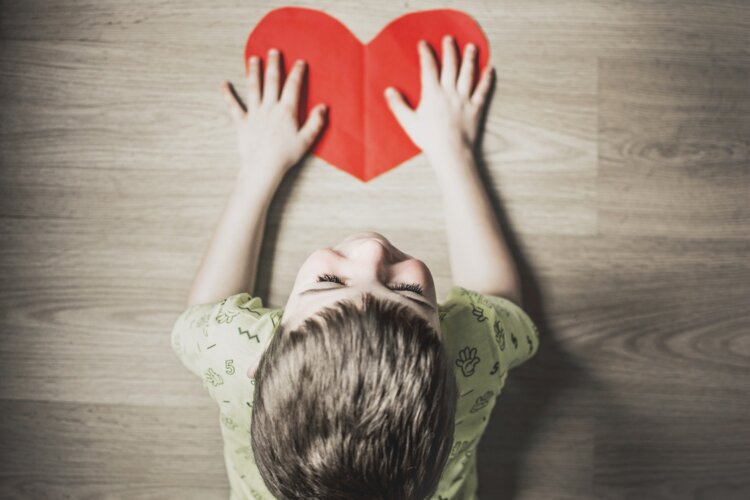
Cultivating gratitude is about more than just saying thank you. Fostering an attitude of gratefulness takes practice and a willingness to constantly evaluate our emotions and experiences. For children, learning about gratitude is a little more complex because they aren’t always developmentally ready to see outside of themselves, especially when big, messy feelings take over the prefrontal cortex.
For children to feel grateful, they often need to be in a place of calm. If they are in distress, they are operating in “lizard brain” or survival mode. They won’t hear any type of message about feeling thankful. But through a few different ways, we can help children better understand gratitude, and begin instilling these important values.
Show our children how to love themselves. It’s hard to feel gratitude for external things when we are struggling to feel love for ourselves. Show children how to love themselves by modeling it yourself! It’s okay to acknowledge when life gets hard, but that doesn’t mean we are failures. When we judge ourselves out loud, our children may look at themselves and wonder if they should be critical of themselves as well. Modeling generosity and kindness to our own bodies and minds will become the internal voice for our children. Say “I love you” to yourself daily and watch how that transforms your perspective, as well as how it influences your child.
Slow down. It’s hard to feel gratitude when you are traveling so fast that time becomes a blur. When you slow down, you notice things. The sound of leaves. A giggle or maybe even tears falling onto tiny cheeks in the backseat. A whisper in the night. Stop and look at your child’s face, eyes, cute little nose. The longer you look, the better you feel. I tell my 8-year-old that a 20 second hug will help him feel better, slow down, and regulate. Gratitude, whether shown through a long hug, or just sitting with that feeling, releases feel-good hormones like oxytocin, serotonin, and dopamine. The more we notice it, sit with it, and experience it, the better we feel.
Holding space for the hard things. It might seem counterintuitive to empathize with a child who is upset when he doesn’t get the gift that he asked for. It would be very easy to view that child as ungrateful. Oftentimes, however, they are expressing a true disappointment, as opposed to implying that we aren’t good enough for not giving them more. Children need help learning the skills of gratitude through empathy and kindness, as well as some guidance.
Try: “You expected to get xyz gift. You must feel disappointed.” After they feel heard, you can then talk about the things that they do have, in a gentle way. “What makes you excited about these toys (this vacation, this day, whatever fits)?” Acknowledging the disappointment and then reframing the situation in a way that doesn’t dismiss their feelings will slowly help them see that though their disappointment is valid and acceptable, there is joy outside of that disappointment.
Reframing “I’m sorry” into “thank you.” I don’t know about you, but I really struggle with saying I’m sorry entirely too much. It’s a constant skill building exercise with friends when we catch our “sorries” and try to reframe them instead. When you catch yourself wanting to apologize for being late, instead of saying sorry, try an act of gratitude: “Thank you for waiting for me.” Change, “I’m sorry I’m so emotional today,” into, “Thank you for supporting me.” Reframing I’m sorry into thank you falls in line with loving yourself. Find gratitude for those who accept you unconditionally, and verbalize and model these experiences for your child.
Finding ways to be grateful when you’re not feeling it
Sometimes life is so hard that it’s difficult to find that feeling of gratitude. A dark cloud hovers over you, and no matter how much you push against it, you can’t get through. This experience is true for children just as much as it is for adults. When you are seeking joy, but can’t find it? Create it. Fake it. Here are some ways to create joy and gratitude with your children (and maybe even with yourself).
Do what makes you laugh. When my kids are struggling, I try to tune into things that make them giggle. Not to hide or stuff feelings, but to bring them back to a regulated state when they feel stuck. Sometimes I’ll tickle them if they say it’s ok. Sometimes we will turn on music and dance around. When everything feels too heavy, step away from the demands of life, if you are able, and just do something fun. If that means skipping a sports practice because your child is stressed to the max, do it.
Come up with mantras together. Our voice becomes their internal voice. Creating mantras together to grab onto in times of crisis and struggle might work wonders for those kids (and adults) who are seeking coping tools.
I love myself.
I am beautiful.
I will get through this.
I am loved.
Keep a gratitude journal or voice it allowed as a daily ritual. Talk with your kids about three things that brought them joy that day. Maybe they heard something funny, ate a good meal, or enjoyed getting to hug you for an extra long time. Bringing gratitude practice into daily life is a powerful tool.
Gratitude doesn’t always come easy for people. It can be difficult to see outside of the heavier emotions, especially for children. By implementing these gratitude practices into your daily lives, it’ll leave a positive lasting impact on your children and yourself.


Grok Nation Comment Policy
We welcome thoughtful, grokky comments—keep your negativity and spam to yourself. Please read our Comment Policy before commenting.